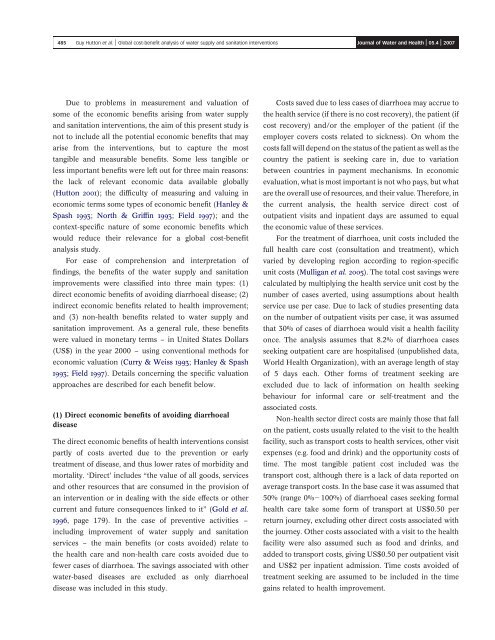Global cost-benefit analysis of water supply and sanitation ... - SuSanA
Global cost-benefit analysis of water supply and sanitation ... - SuSanA
Global cost-benefit analysis of water supply and sanitation ... - SuSanA
You also want an ePaper? Increase the reach of your titles
YUMPU automatically turns print PDFs into web optimized ePapers that Google loves.
485 Guy Hutton et al. | <strong>Global</strong> <strong>cost</strong>-<strong>benefit</strong> <strong>analysis</strong> <strong>of</strong> <strong>water</strong> <strong>supply</strong> <strong>and</strong> <strong>sanitation</strong> interventions Journal <strong>of</strong> Water <strong>and</strong> Health | 05.4 | 2007<br />
Due to problems in measurement <strong>and</strong> valuation <strong>of</strong><br />
some <strong>of</strong> the economic <strong>benefit</strong>s arising from <strong>water</strong> <strong>supply</strong><br />
<strong>and</strong> <strong>sanitation</strong> interventions, the aim <strong>of</strong> this present study is<br />
not to include all the potential economic <strong>benefit</strong>s that may<br />
arise from the interventions, but to capture the most<br />
tangible <strong>and</strong> measurable <strong>benefit</strong>s. Some less tangible or<br />
less important <strong>benefit</strong>s were left out for three main reasons:<br />
the lack <strong>of</strong> relevant economic data available globally<br />
(Hutton 2001); the difficulty <strong>of</strong> measuring <strong>and</strong> valuing in<br />
economic terms some types <strong>of</strong> economic <strong>benefit</strong> (Hanley &<br />
Spash 1993; North & Griffin 1993; Field 1997); <strong>and</strong> the<br />
context-specific nature <strong>of</strong> some economic <strong>benefit</strong>s which<br />
would reduce their relevance for a global <strong>cost</strong>-<strong>benefit</strong><br />
<strong>analysis</strong> study.<br />
For ease <strong>of</strong> comprehension <strong>and</strong> interpretation <strong>of</strong><br />
findings, the <strong>benefit</strong>s <strong>of</strong> the <strong>water</strong> <strong>supply</strong> <strong>and</strong> <strong>sanitation</strong><br />
improvements were classified into three main types: (1)<br />
direct economic <strong>benefit</strong>s <strong>of</strong> avoiding diarrhoeal disease; (2)<br />
indirect economic <strong>benefit</strong>s related to health improvement;<br />
<strong>and</strong> (3) non-health <strong>benefit</strong>s related to <strong>water</strong> <strong>supply</strong> <strong>and</strong><br />
<strong>sanitation</strong> improvement. As a general rule, these <strong>benefit</strong>s<br />
were valued in monetary terms – in United States Dollars<br />
(US$) in the year 2000 – using conventional methods for<br />
economic valuation (Curry & Weiss 1993; Hanley & Spash<br />
1993; Field 1997). Details concerning the specific valuation<br />
approaches are described for each <strong>benefit</strong> below.<br />
(1) Direct economic <strong>benefit</strong>s <strong>of</strong> avoiding diarrhoeal<br />
disease<br />
The direct economic <strong>benefit</strong>s <strong>of</strong> health interventions consist<br />
partly <strong>of</strong> <strong>cost</strong>s averted due to the prevention or early<br />
treatment <strong>of</strong> disease, <strong>and</strong> thus lower rates <strong>of</strong> morbidity <strong>and</strong><br />
mortality. ‘Direct’ includes “the value <strong>of</strong> all goods, services<br />
<strong>and</strong> other resources that are consumed in the provision <strong>of</strong><br />
an intervention or in dealing with the side effects or other<br />
current <strong>and</strong> future consequences linked to it” (Gold et al.<br />
1996, page 179). In the case <strong>of</strong> preventive activities –<br />
including improvement <strong>of</strong> <strong>water</strong> <strong>supply</strong> <strong>and</strong> <strong>sanitation</strong><br />
services – the main <strong>benefit</strong>s (or <strong>cost</strong>s avoided) relate to<br />
the health care <strong>and</strong> non-health care <strong>cost</strong>s avoided due to<br />
fewer cases <strong>of</strong> diarrhoea. The savings associated with other<br />
<strong>water</strong>-based diseases are excluded as only diarrhoeal<br />
disease was included in this study.<br />
Costs saved due to less cases <strong>of</strong> diarrhoea may accrue to<br />
the health service (if there is no <strong>cost</strong> recovery), the patient (if<br />
<strong>cost</strong> recovery) <strong>and</strong>/or the employer <strong>of</strong> the patient (if the<br />
employer covers <strong>cost</strong>s related to sickness). On whom the<br />
<strong>cost</strong>s fall will depend on the status <strong>of</strong> the patient as well as the<br />
country the patient is seeking care in, due to variation<br />
between countries in payment mechanisms. In economic<br />
evaluation, what is most important is not who pays, but what<br />
are the overall use <strong>of</strong> resources, <strong>and</strong> their value. Therefore, in<br />
the current <strong>analysis</strong>, the health service direct <strong>cost</strong> <strong>of</strong><br />
outpatient visits <strong>and</strong> inpatient days are assumed to equal<br />
the economic value <strong>of</strong> these services.<br />
For the treatment <strong>of</strong> diarrhoea, unit <strong>cost</strong>s included the<br />
full health care <strong>cost</strong> (consultation <strong>and</strong> treatment), which<br />
varied by developing region according to region-specific<br />
unit <strong>cost</strong>s (Mulligan et al. 2005). The total <strong>cost</strong> savings were<br />
calculated by multiplying the health service unit <strong>cost</strong> by the<br />
number <strong>of</strong> cases averted, using assumptions about health<br />
service use per case. Due to lack <strong>of</strong> studies presenting data<br />
on the number <strong>of</strong> outpatient visits per case, it was assumed<br />
that 30% <strong>of</strong> cases <strong>of</strong> diarrhoea would visit a health facility<br />
once. The <strong>analysis</strong> assumes that 8.2% <strong>of</strong> diarrhoea cases<br />
seeking outpatient care are hospitalised (unpublished data,<br />
World Health Organization), with an average length <strong>of</strong> stay<br />
<strong>of</strong> 5 days each. Other forms <strong>of</strong> treatment seeking are<br />
excluded due to lack <strong>of</strong> information on health seeking<br />
behaviour for informal care or self-treatment <strong>and</strong> the<br />
associated <strong>cost</strong>s.<br />
Non-health sector direct <strong>cost</strong>s are mainly those that fall<br />
on the patient, <strong>cost</strong>s usually related to the visit to the health<br />
facility, such as transport <strong>cost</strong>s to health services, other visit<br />
expenses (e.g. food <strong>and</strong> drink) <strong>and</strong> the opportunity <strong>cost</strong>s <strong>of</strong><br />
time. The most tangible patient <strong>cost</strong> included was the<br />
transport <strong>cost</strong>, although there is a lack <strong>of</strong> data reported on<br />
average transport <strong>cost</strong>s. In the base case it was assumed that<br />
50% (range 0%2100%) <strong>of</strong> diarrhoeal cases seeking formal<br />
health care take some form <strong>of</strong> transport at US$0.50 per<br />
return journey, excluding other direct <strong>cost</strong>s associated with<br />
the journey. Other <strong>cost</strong>s associated with a visit to the health<br />
facility were also assumed such as food <strong>and</strong> drinks, <strong>and</strong><br />
added to transport <strong>cost</strong>s, giving US$0.50 per outpatient visit<br />
<strong>and</strong> US$2 per inpatient admission. Time <strong>cost</strong>s avoided <strong>of</strong><br />
treatment seeking are assumed to be included in the time<br />
gains related to health improvement.
















